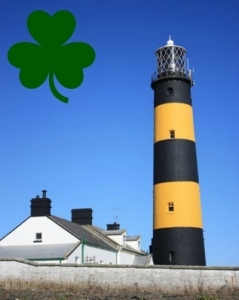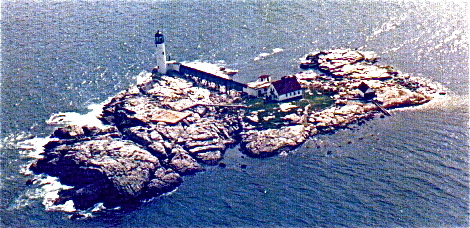Marilyn Turk's Blog, page 11
March 11, 2016
St. John’s Point LIghthouse in St. Patrick’s Land
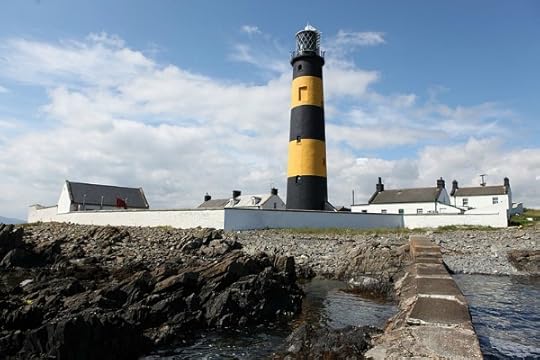
St. John’s Point Lighthouse, Ireland, photo by Storefix, wikimedia commons
Just down the road from the first church built by St. Patrick stands St. John’s Point Lighthouse.
Set near ancient ruins, the lighthouse is located on the most easterly point of Ireland and marks the entrance to Dundrum Bay, an area notorious for the high number of shipwrecks resulting from hidden reefs.
Since its inception in 1839, St. John’s Point Lighthouse has been an important part of Ireland’s history. As the tallest land lighthouse on the Irish coast, the lighthouse served as a marker for the Titanic as it made its trial runs in 1912.
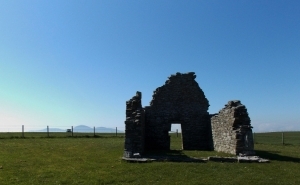
ruins of church near St. John’s Point
In 1918, the lighthouse witnessed the sinking of a merchant ship after it was torpedoed by a German U-boat. In World War II, the lighthouse became a temporary home for United Kingdom evacuees, as well as, a military station for British and American troops. The site also housed a camp for German prisoners of war.
The lighthouse was fully automated in 1981, and the keepers were withdrawn. And in 2011, the fog horn was the last in the country to be deactivated. St. John’s Point has been named one of the twelve Great Lighthouses of Ireland and is one of the most visited by tourists, who can now stay in one of the recently renovated keepers’ cottages.
Recently, the Commissioners of Irish Lights (CIL) proposed replacing the current lamp which rotates in a bath of mercury, citing the dangers of mercury poisoning. In its place, the CIL wants to put a static, flashing, LED light, a cost-saving measure. Locals intent on preserving the heritage of the lighthouse have begun a campaign to retain the original antique lamp with its sweeping beam. The present lamp is a six ton, first order, two tier rotating Fresnel lens with three panels on each level. The lower tier is the main light while the upper tier is the reserve light. The current range of the light is 25 miles. The range of the suggested replacement will be about 18 miles.
Will progress prevail or will tradition be preserved?
Time will tell whether the lighthouse has “the luck of the Irish.”
“Remember the days of old, consider the years of many generations.” Deut. 32:7a
March 3, 2016
Lighthouse Kids to the Rescue

White Island (Isles of Shoals) Lighthouse
People on the New Hampshire seacoast knew it was out there.
Several miles from shore, on the southern tip of White Island in the Isles of Shoals, the only lighthouse off the coast of New Hampshire, sat sadly alone and decaying.
Built in 1859, the White Island Lighthouse had seen keepers, their families, and Coast Guard come and go. It had witnessed shipwrecks and rescues. It had also weathered blizzards and Atlantic storms, including the “Perfect Storm” of 1991.

White Island Lighthouse, old photo
The lighthouse lost its inhabitants in 1986, when the light became automated and no one was needed to man it anymore. The abandoned lighthouse was eventually turned over to the state of New Hampshire’s Parks Department, but the buildings continued to deteriorate.
Locals would talk about the lighthouse and its plight, shaking their heads about the result of years of neglect. “Someone should do something,” they’d say. But no one stepped forward to help the lighthouse.
No one, that is, until a school teacher named Susan Reynolds, became so upset about the situation that she did something. Susan had spent summers on the beach as a child, staring out at the lighthouse and planning to visit it in person as an adult. The lighthouse was important to her and important to the history of the area.
So in 2000, Reynolds formed a community service group with her seventh grade students to raise money and spur interest in saving and preserving the lighthouse. Called the “Lighthouse Kids,” the group became a nonprofit organization devoted to service projects and volunteer efforts for the cause. Another group called Friends of the Lighthouse Kids consisting of more than 150 adults joined the Kids to support them and their work for the lighthouse.
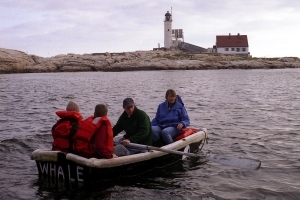
LIghthouse Kids on their way to the lighthouse, photo courtesy Jeremy D’Entremont.
One of the activities the Lighthouse Kids did was send letters to businesses and individuals asking for donations. They also sent letters to state and local officials asking for help with restoring the lighthouse. As a result, the group was awarded a grant in 2003 that allowed them to have major repairs done.
Since that time, the Kids have continued their efforts, even as they’ve grown into adulthood and new kids have joined the group. Renovations have included repairing cracks in the brick tower, repainting it, putting a new roof and new windows in the keeper’s cottage, and replacing the covered walkway that connected the tower and the cottage.
In addition, the Lighthouse Kids have kept close contact with the Coast Guard, who still maintains the light, its solar panels, and the fog signal.
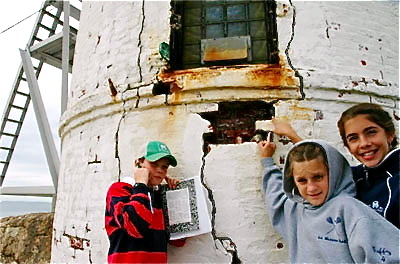
Lighthouse Kids inspect damage to lighthouse
The Kids have also started a Stewardship program with “stewards” who go the island to clean up the station, host visitors, paint and handle ongoing repairs.
Thanks to one person’s vision and a bunch of eager kids, White Island Lighthouse is now restored and ready for company. “Do What’s Right, Save the Light,” their motto, is worth remembering when it comes to lighthouse preservation.
“Even a child is known by his deeds,
Whether what he does is pure and right.” Proverbs 20:11
For more information, see http://www.lighthousekids.com.
February 19, 2016
Lighthouses and Sea Serpents
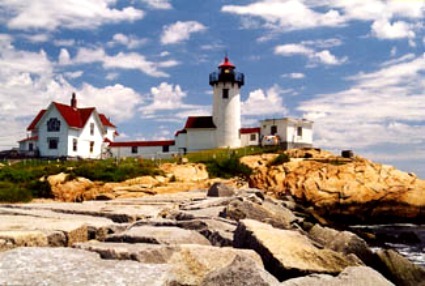
Eastern Point Lighthouse, Gloucester, MA, photo courtesy Kraig Anderson
Massachusetts’ Gloucester Harbor is known as America’s oldest seaport, supporting fishermen, whalers, traders and even smugglers since 1616. The area is also known for its dangerous currents, ledges, and storms which claimed 779 vessels and 5,305 lives between 1830 and 1910.
But another danger also lurked in the waters nearby – the Gloucester Sea Serpent. The first recorded sighting of the monster was in 1848 by John Josselyn Gent. Gent raised his gun to shoot the monster, but was stopped by an Indian who said killing the serpent would bring bad luck. In 1817, Amos Story, future keeper of Gloucester’s Ten Pound Island Light, reported seeing the beast. He said, “I saw a strange marine animal that I believe to be a serpent… His head appeared shaped much like that of the sea turtle and he carried his head from ten to twelve inches above the surface of the water.” Story ‘s wife also reported seeing the serpent lounging on the rocks, thinks at first it was a log until it slithered into the water. Sixteen other sightings reported the monster who was nicknamed “His Snakeship.” Although the town offered a $5000 reward, the beast was never caught.
Sightings of His Snakeship continued along the coast of Massachusetts during the 1800s. Often seen near lighthouses like the Eastern Point Lighthouse, the creatures were thought to be attracted to the towers or its lights.
Theobold Rooney, keeper at St. Andrews Lighthouse at Sand Reef off New Brunswick, Canada, reported a sea monster passing his lighthouse in 1906. Rooney claimed the beast was twenty to thirty feet long and had a snakelike head.
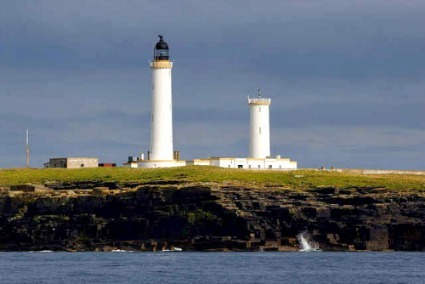
Pentland Skerries, photo by Ian Cowe
At Scotland’s Pentland Skerries Light, lightkeeper John Brown reported a huge sea creature near his lighthouse. “A great object rose up out of the water; anything up to twenty to thirty feet … it was round-shaped and appeared to have a head.”
Sea monsters were also sighted on the Pacific Coast. Not far from the lighthouse on Discovery Island, a family was sailing when they heard a loud noise behind their boat described as a grunt or a snort. They looked back and saw a large creature watching them. The greenish-brown beast had a distinct head and serrated markings along its back and sides. The animal dove and resurfaced farther away, still observing the people in the boat before it dove again. Other sightings of a snakelike, toothed dorsal fin, ninety to one hundred feet long, dark green or brown, hissing, snorting creature were reported in the area as well.
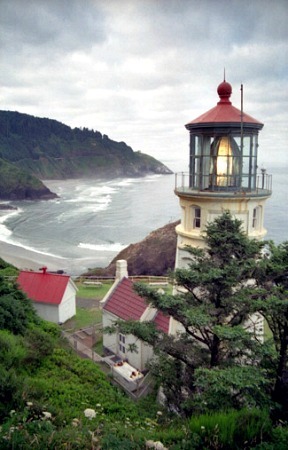
Haceta Head Lighthouse, Oregon, photo courtesy lighthousefriends.com
The first mate aboard the Columbia River Lightship reported seeing a sea creature in 1934 he named “Colossal Claude.” He described Claude as about forty feet long with “a neck some eight feet long, a big round body, a mean-looking tail, and an evil, snaky look to its head.” Three years later the creature was sighted by a fishing trawler off the Washington Coast and two months after that was reported fifty miles south near Haceta Head Lighthouse. A couple who saw the creature described it as having a horselike head with ears and a seaweed-colored mane. Its neck and back had a row of bumps.
In 1953, the creature was sighted near New Dungeness Lighthouse in Washington, then in 1969, two fishermen sighted it near Discovery Island Lighthouse, British Columbia, noticing its “large red eyes and short ears.”
Various theories exist as to what these creatures are, if in fact, they’re real. Some suggest they’re species that have survived since prehistoric times. Others propose that sea monsters may just be large whales or sharks, frightening creatures concocted by overactive imaginations. Movies such as The Foghorn, The Monster of Piedras Blancas, and even Godzilla have preyed upon these sightings. Strangely enough, a lighthouse is usually depicted as the victim of the creature in these films.

from the movie, “The Foghorn”
Do you believe such creatures exist? “Leviathan” is referred to in the Bible several times, including the book of Job, believed to be the oldest book of the Bible. Translated from ancient Hebrew, the word means “coiled or twisted” and refers to a sea serpent. So sea serpents existed at some time, but do they still exist?
“So God created the great creatures of the sea and every living thing with which the water teems, and that moves in it” Genesis 1:21 (NIV)
*story sources: The Lighthouse Menagerie by Elinor De Wire and http://lighthousefriends.com/
February 12, 2016
Love Signals from the Lighthouse
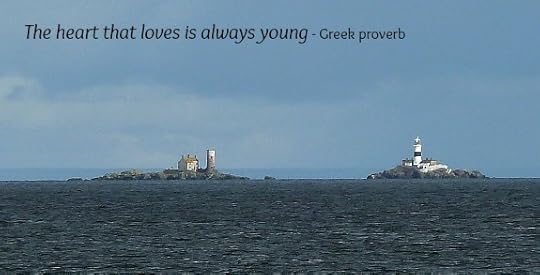
The Maidens Lighthouses, Ireland
Where did a young person who lived at a lighthouse meet other young people? How did they find someone to date, fall in love with, and marry?
At other lighthouses, of course. Due to the remoteness of lighthouses, the children of keepers often met and married the children of other keepers – people who lived the same type of lives as they.
Off the coast of Northern Ireland lies a group of islets, marine hazards since the early days of shipping.
The two largest islands, about half a mile apart, are called The Maidens, and in 1829, a lighthouse was built on each one.
Hugh Redmond, lighthouse keeper at one of the lighthouses during the 1800’s, had a daughter. When the daughter met the assistant keeper at the other Maiden lighthouse, it was love at first sight. The young couple visited each other by boat if possible, but many times they couldn’t. Still, the need to communicate was strong. So how did the young couple speak to each other across the water before the invention of cell phones?

I LOVE YOU in Semaphore
Semaphore, the system of signaling with flags, was the only way. The couple became known as the “Maidens Lovers” and signaled their messages of affection from one island to the other. However, legend says that the parents disagreed about the romance and tried to end it. But love couldn’t be kept apart, so the couple eloped and married.
Apparently, semaphore was used in the courtship of another couple, Pauline Fitzgerald and Larry Butler. Both of them came from lightkeeping families, and when Pauline’s father was stationed on Eagle Island, she met young Assistant Keeper Larry. Soon the attraction grew to the point that Pauline’s father noticed it and sent her back to Dublin where she was to continue her nursing career. But Larry couldn’t let her go, followed her and proposed. Then they too, eloped.
What happened to Pauline and Larry? They became parents to fifteen children and served at several Irish lighthouse stations. At Galley Head Lighthouse, Pauline became Assistant Keeper. Two of their children continued the family tradition and became lightkeepers too.
So how will you tell your sweetheart how much you care for him/her this Valentine’s Day – with a card, flowers, an email, a text? How about semaphore?

Galley Head Lighthouse, Ireland, photo from wikipedia public domain
Thank God for the gift of love!
Dear friends, let us love one another, for love comes from God. Everyone who loves has been born of God and knows God.” 1 John 4:7
February 6, 2016
How Lighthouse Keepers Spent Their Free Time

Casquets Lighthouse, UK, photo courtesy Trinity House
Lighthouse keepers had a 24/7 job, but even they had free time, especially on stations where their families weren’t allowed. When the sea was peaceful and the duties were done, what did a light keeper do with his time?
Of course many lightkeepers liked to fish, and a lighthouse was located in a perfect place for such a pursuit. In addition, lightkeepers often used their time to catch up on reading – books brought with them or magazines delivered with their relief supplies. Others listened to music with whatever device worked in such remote locations, from records to tapes in the twentieth century.
When Terry Branfield was a relief keeper at Longships Lighthouse off Land’s End in Cornwall, he discovered that the other keepers at the lighthouse enjoyed making rope mats. Terry learned the craft and pleased his mother with a new rope mat on his next trip home.
Many lighthouse keepers took advantage of their solitude to take correspondence courses from colleges, improving their skills or adding to their knowledge.
One of the keepers at Needles Lighthouse in the U.K. had recording equipment that enabled him to record books designated for the blind.
At Casquets Lighthouse, there was enough land for the principal keeper to construct a driving range and practice his golf swing. This feat was accomplished by applying netting over a framework of old scaffolding material. During bad weather, he used the bedroom hallway for a putting green. The keeper eventually used his improved golf skills to become manager of a golf club.
Keeper Gordon Partridge discovered a use for extra wood carpenters left at the lighthouse to create a doll house for a family member. Partridge said the most difficult aspect of making the dollhouse was transporting it back home aboard a commercial airplane. Lesson learned, his future doll house constructions were made in panels that could be assembled at their destination.
Other keepers applied themselves to the craft of building ships in bottles or light bulbs, a hobby which required great patience and a lot of uninterrupted time. Still other keepers made knot display boards, a popular item to sell on the mainland.
At Marblehead Lighthouse on Lake Erie, Keeper Charles Hunter kept busy during the three winter months when the light was inactive with several hobbies. He carved a grandfather’s clock, as well as, wove beautiful tapestries of nautical scenes, and even wrote short stories.
These keepers made good use of their hands and their time, dispelling the image of a bored lighthouse keeper.
What do you do with your free time? Are you bored? Maybe you could take up a hobby too.
“May the favor of the Lord our God rest on us; establish the work of our hands for us—
yes, establish the work of our hands.” Psalm 90:17

Marblehead Lighthouse, Ohio, photo courtesy lighthousefriends.com
January 30, 2016
The Optimistic Lighthouse Keeper
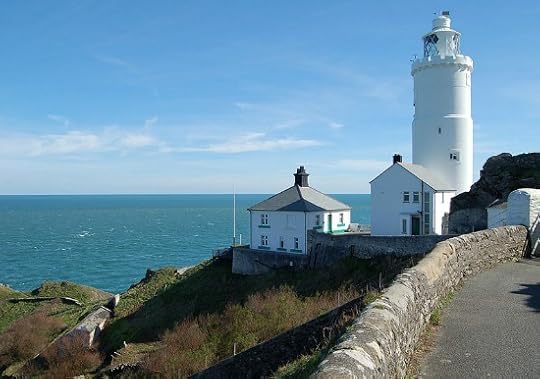
Start Point Lighthouse, Devon, UK, source Wikipedia Commons, photo by Nilfanion
Gordon knew it was only a matter of time before his occupation and his way of life would be gone.
Trinity House, the governing body of lighthouses in the United Kingdom, had detailed to its lighthouse keepers the plans to automate the lighthouses. First on the list would be the rock stations – those remote stations that could only be serviced by boat or helicopter – due to their expense.
After sixteen years in the lighthouse service, Gordon Partridge became Senior Assistant Keeper at Start Point Lighthouse in Devon, U.K. when most of the offshore lighthouses had been turned over to automation. Start Point was a land station, more accessible to the public and closer to home for Gordon. However, it too, would become unmanned when the new technology was installed there.
For some lighthouse keepers, the intrusion of automation into their lives was feared and unwelcome. Many of the older lighthouse keepers wanted nothing to do with the technology that would replace them, so many took retirement.
Gordon’s attitude was different, though. The same attitude which carried him through years of lighthouse service continued as automation approached. Gordon saw the need to adapt to the change and to apply himself to the necessary training.
In his words, “I have always enjoyed any form of offered training, and in particular, relished the opportunity of learning, at least a little, of this new computer age.”
His positive attitude and enthusiasm toward the new training also resulted in making himself more valuable to the lighthouse service, therefore becoming an asset in the transfer of the lighthouses from keepers to computers.

Flat Holm Lighthouse, Flat Holm Island, UK
He completed twenty-two years in the lighthouse service, having served at over twenty different stations. During that time, he experienced a variety of living conditions, personalities, difficulties and challenges.
So what did he think about his demanding job? For one thing, Gordon saw the opportunity to travel to so many different places an exciting perk to his career. When he was on a rock tower in the middle of the ocean, he used his free time to read or pursue hobbies. When he was on an uninhabited island, he saw the chance as a gift to explore the territory others might never see. When he was at a land station, he had the opportunity to ride a bicycle into town and familiarize himself with the community.
Gordon scoffs at those who perceive a lighthouse keepers’ life as dull and monotonous. He has often been asked if it was boring, to which he replies, “Never!”
Perhaps another lighthouse keeper would see the job for all its problems and challenges. But Gordon’s positive attitude reflects a verse in the Bible which is good advice for all of us.
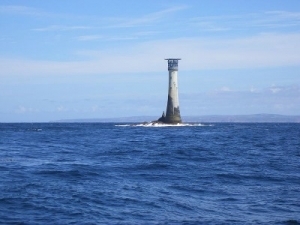
Wolf Rock Lighthouse, photo by Alvaro, wikicommons
“Finally, brothers and sisters, whatever is true, whatever is noble, whatever is right, whatever is pure, whatever is lovely, whatever is admirable—if anything is excellent or praiseworthy—think about such things.” Philippians 4:8 NIV
Sometimes this attitude is called looking at the glass “half-full” instead of “half-empty.” Which of these attitudes describe you? Which one would show better results?
*Thank you to Gordon Partridge, who shared his life as a lighthouse keeper in his book, Hands That Made Lights Work.
January 28, 2016
Announcing a new, affordable Christian writers conference!
Want to write a novel? Curious about writing magazine articles? Wonder what all that “writer language” means? Join us at the Blue Lake Christian Writers Retreat April 20-23, 2016. Our award-winning faculty and professionals will be there to help. For more information, visit: http://bluelakecwr.com/
Register early to reserve your spot!
January 22, 2016
The Lighthouse Cat
Cats have been friends of mariners for centuries.
They had an important job on ships – to keep the vessel free of rats and mice that not only ate food supplies, but gnawed through the ships’ ropes. Cats were also common along waterfronts where they controlled rodents in warehouses and helped clean up the remains from fish processing.
Mariners had a high respect for cats, often believing them to have special powers. Although considered unlucky in some places, having a black cat on board a ship was believed to offer protection from dangerous weather. Even fishermen’s wives kept black cats at home in hopes that they would protect their husbands at sea.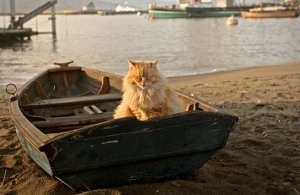
Polydactyl cats (with more than the usual number of toes) were popular sea cats because they were thought to have more balance and be better mouse-catchers. Some people believed storms were stored in cat tails, as evidenced by the static electricity that appeared when a cat was petted, making it taboo to pet a cat. If a ship’s cat fell overboard, the ship might be hit by a terrible storm, and if the ship didn’t sink, it would be cursed with nine years of bad luck. Some other feline superstitions concerning weather included – if a cat licked its fur against the grain, a hailstorm was coming; if a cat sneezed, it meant rain; and if a cat was frisky, expect windy conditions.

Highland Light, Cape Cod, MA
Cats often survived shipwrecks and took up residence at nearby lighthouses. People living near Cape Cod believe the area’s high number of polydactyl cats is a result of ship rescues by Cape Cod lightkeepers. At lighthouses, cats were as valuable as they had been on ships, catching rodents and even eating bugs that were drawn to the light. Cats were also alleged to forecast weather at lighthouses. If a cat slept with its back to low pressure and cold, it signaled the arrival and direction of a weather front. If a storm was coming, a cat’s keen ears could hear it in advance, evidenced when the cat went into hiding in expectation of the storm.
Of course, cats proved great companions in lonely lighthouse posts, providing warmth and comfort in cold, uninsulated buildings.
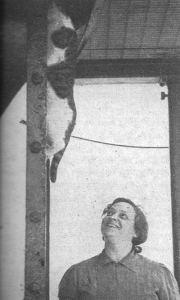
The Climbing Cat of Deer Island Light
Perhaps Deer Island Light’s most famous resident was “The Climbing Cat.” The cat was well-known for its ability to climb ladders and negotiate the uneven levels of the lonely caisson lighthouse guarding the passage into Boston Harbor. More than an agile climber, the cat was also an excellent fisherman. The feline would descend to the lowest level of the light and sit there, studying the water. When she spotted a fish, she’d leap into the water, disappearing underneath a few moments before surfacing with a wiggling fish in her mouth. Then she’d swim back to the tower and climb up the ladder with her prize, ready for a private feast.
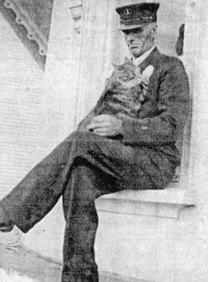
Keeper Eugene Coleman and Sambo, photo by William O. Thompson, courtesy Jeremy D’Entremont
Sambo was another famous lighthouse cat. Around 1929, Sambo Tonkus (Mr. T) was born at the Nubble Lighthouse. Sambo stayed at Nubble even when the keepers changed. The ginger-striped tabby grew to be a hefty twenty pounds. After clearing the island of its rodents, he decided to go to the mainland for more. Sambo would saunter down to the water’s edge, wade in, and swim over the channel to the mainland. A few hours later, he’d return with a mouse in his jaws before swimming back to the lighthouse island with his dinner. As word spread of his exploits, tourists lined the shore waiting for Sambo to make his swim so they could take pictures of the event.
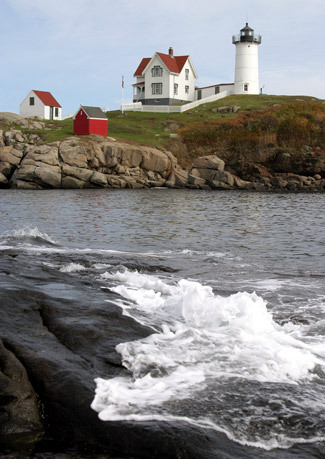
Cape Neddick, Nubble Light, photo courtesy lighthousefriends.com
God created a vast variety of animals, each for a purpose.
Even cats have a purpose in God’s plan.
“You are worthy, our Lord and God,
to receive glory and honor and power,
for you created all things,
and by your will they were created
and have their being.” Rev. 4:11
January 15, 2016
Work at the Lighthouse

McNab’s Island Lighthouse on Maugher’s Beach, Nova Scotia
“No fair! Why do I have to do all the work?”
Maybe you’ve heard this complaint before, but you wouldn’t have heard it from lighthouse keepers or their families.
Lighthouse keeping wasn’t an easy lifestyle, but for lighthouse families, it was a busy, active life. In Nova Scotia, most lighthouse keepers were married, a preferred status in the lighthouse service. Keeping a lighthouse and providing for a family took a lot of work, and family members helped share the responsibility.
On remote islands, these families became their own communities – self-sufficient, organized and functional. Most of the parents and children in these locations embraced their lifestyle. As a former lighthouse keeper’s child said, “family life was very close because that’s all you had.
Such was the case with the Cleveland family when Keeper Colin Cleveland, his wife and seven children moved to little three-mile McNab Island near Halifax in 1932.
Keeper Cleveland’s work kept him very busy, but he was never too busy to pitch in and help get the children up and ready for school each day before he took them by boat to school on the mainland. Then he returned to the island where he not only maintained the equipment of the lighthouse, he cleared land for gardens and took care of the livestock.
His children remember him as a happy man as he went about his work, and whether working in the lighthouse or cutting wood, he could be heard singing. One of his daughters recalled him sitting on scaffolding as he painted the lighthouse singing “Onward Christian Soldiers” at the top of his voice. No doubt Keeper Cleveland’s positive attitude helped motivate his family.
There were plenty of difficulties a keeper faced – tending the light all night, manning the fog horn sometimes for hours, and often living in cramped, drafty homes without electricity or running water – to name a few. He could complain, which wouldn’t accomplish anything or change his circumstances, or like Mr. Cleveland, he could embrace his work, thankful for the opportunity and committed to his responsibility. Perhaps that’s why he remained keeper of McNab Island lighthouse for twenty-five years.
One of the wisest men that ever lived, King Solomon, once said, “So I saw that there is nothing better for a person than to enjoy their work, because that is their lot.” Ecc. 3:22
Do you enjoy your work? If not, how would changing your attitude toward it help?
January 9, 2016
Cape Canaveral Lighthouse – New Year and New Friends

Cape Canaveral Lighthouse, photo courtesy of NASA
When Cape Canaveral Lighthouse was first lit in 1848, its location was so remote, no one but the keeper and his family lived near it.
However when the Civil War broke out in 1861, Keeper Mills Burnham had unexpected company. Under the orders of the new Confederate Light House authorities, he was commanded to remove the lighting apparatus of the lighthouse to assure that offshore Union ships would not benefit from its light and not be warned of the dangerous shoals which extended for twelve miles off the cape. Burnham did as he was instructed, taking the apparatus apart, crating it up and moving it to his orange grove where he buried it.
Keeper Burnham, his wife and five daughters lived in their home in the orange grove while the lighthouse stayed dark throughout the war. Two Union camps were in the area, but Burnham’s family was safe from intrusion as Union blockade ships patrolled the ocean nearby.
Unfortunately, civilian boats were impacted by the missing light in the lighthouse too, and in 1865 a small schooner from New York wrecked just off the cape. Two sailors drowned, but the captain, his wife and three other sailors made it to shore. When they went to the lighthouse, they found it deserted. However, they managed to find the Burnham’s home in the orange grove where the starving survivors were provided with a warm fire, food and clothing and were nursed back to good health.
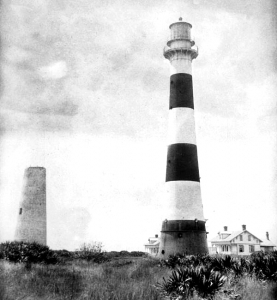
Cape Canaveral Lighthouse, new and old, photo courtesy State Archives of Florida
When the war was over, Burnham was able to retain his position as lighthouse keeper at the lighthouse, but the government decided to build a newer, taller tower to replace it. Therefore, it was 1868 before the new Cape Canaveral’s lighthouse was lit, and Burnham stayed in his position until his death in 1896.
The lighthouse was still active when, in the 1950’s, it acquired a noisy new neighbor. The Cape Canaveral Joint Range Proving Ground began launching rockets, disturbing residents of towns that had sprung up nearby. Soon the towns became government property and the citizens left, but the lighthouse keepers, being government employees, were allowed to remain. However, in 1967, the lighthouse was automated and the keepers were removed.
In 2000, the 151-foot tall Cape Canaveral Lighthouse became the only lighthouse to be owned and operated by the U.S. Air Force. In the years since, visitors have been allowed to tour the lighthouse at various times, but visits ended in 2013, due to government budget cuts. Now, thanks to a joint effort between the Air Force, the Cape Canaveral Lighthouse Foundation, and NASA, tours to the lighthouse have commenced again, and the lighthouses can welcome visitors once more.
“Do not forget to show hospitality to strangers, for by so doing some people have shown hospitality to angels without knowing it.” Hebrews 13:2
Is there someone you can show hospitality to this year?

